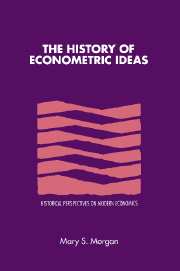Conclusion
Published online by Cambridge University Press: 26 October 2009
Summary
Haavelmo's 1944 paper marks the end of the formative years in econometrics and the beginning of its mature period. His treatise set out the best methods for the practice of econometrics and explained the reasoning behind these rules. His novel ideas on the role of probability pointed the future way for econometrics, but in many other respects the concepts and approach of Haavelmo's programme were firmly rooted in the past. In his hands, the individual practical solutions and insights generated by the earlier work were finally fitted together as in a completed jigsaw puzzle, showing one single econometrics applicable to all branches of economics.
The coherence of Haavelmo's blueprint derived from a deep understanding of how econometrics worked as an applied science. His paper contained the most explicit and rewarding discussion in econometrics about its most fundamental problem: the problem of non-experimental data that come from
the stream of experiments that Nature is steadily turning out from her own enormous laboratory, and which we merely watch as passive observers.
(Haavelmo (1944), p. 14)Clearly, econometricians could not isolate or control such data to match their theory, as in the ideal type of experiment – and here I return to the themes of my Introduction. Haavelmo suggested an alternative form of experimental design, in which economic theory could be constructed to meet the conditions of the data. But, for practical econometrics, he recognised that elements of both design types would be required.
- Type
- Chapter
- Information
- The History of Econometric Ideas , pp. 259 - 264Publisher: Cambridge University PressPrint publication year: 1990

